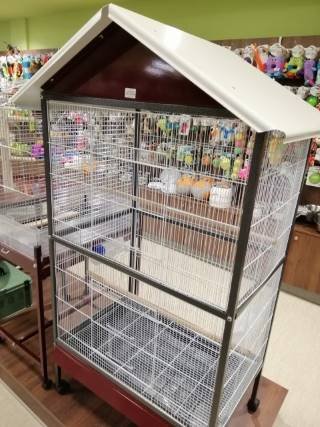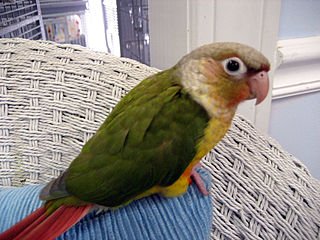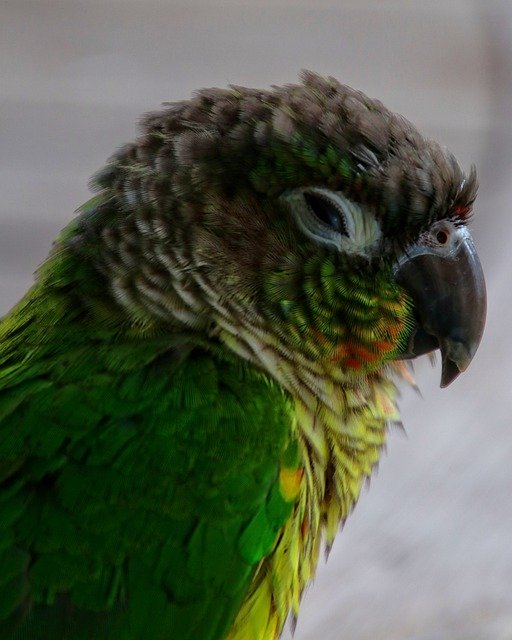Native to the Amazon rainforests south-central region, Crimson-bellied Conures have a liking for dense vegetation. Also found in secondary forest areas of Bolivia and Brazil, they are the most preferred species from the conure family. Known to be the quietest and cuddliest conure, they are easily told apart due to their distinct multi-colored plumage with a characteristic crimson belly.
Crimson-bellied Conure Lifespan
In the wild, Crimson-bellied Conure lifespan averages around 14 years that is comparatively less than they live in captivity. This difference in longevity is due to a few factors like non-availability of adequate nutrition, lack of care, and facing dangers from predators, et al.
Crimson-bellied Conure lifespan in captivity averages more than their lifespan in the wilderness courtesy all the general and medical care by the owner and a nutritious diet. They easily live for roughly 20 years or sometimes, even beyond it in captivity.
Crimson-bellied Conure Talking Ability
Crimson-bellied conures aren’t known to be the talkers of the conure family. Rather surprisingly, they are so quiet that they are a preferred apartment bird. They do not like to talk much. And about learning the art of communication and remembering the vocabulary, they are nowhere close to African Greys or even Quaker Parrots. They can learn to speak a few words at most.
Crimson-bellied Conure Gender Differences
Crimson-bellied Conures are monomorphic and both the sexes can hardly be told apart by simply looking at them. Though for the experts, a few physical differences are enough to accurately identify the bird’s gender.
Crimson-bellied Conure Size
Size is the most basic physical difference to determine the crimson-bellied gender. Where the Crimson-bellied males happen to be around 10 inches, their female counterparts are a little smaller in size, roughly at 9 inches.
Crimson-bellied Conure Weight
The Crimson-bellied males are comparatively heavier than the females. Where males weigh around 94 grams, the females have an average weight of 79 grams.
Crimson-bellied Conure Scientific Testing
This is the most accurate way of knowing the bird’s gender and includes either of the following methods:
Surgical Sexing- An invasive method that needs to administer anesthesia to the bird. An arthroscope is inserted via an incision on the lower abdomen to check the male or female reproductive organs.
DNA Testing- Much like humans, blood samples are required to determine the bird’s gender accurately.
Crimson-bellied Conure Breeding
To know crimson-bellied conure breeding, let’s learn about all the aspects involved.
Crimson-bellied Conure Nesting Requirements
Crimson-bellied conures love to nest in dark and cozy places. They line their nests with wood dust.
For the cage dwellers, a special nesting box can encourage breeding behavior. Attach around 9-10 inches square nest box to the dark and rear end of his daily cage. Line this nest box with organic wood shavings or wood dust to add warmth to it.
For the aviaries, a few hollow logs of varied sizes lined with wood dust can be hanged. Let the pair choose the one they like the most. Remove all other logs once the pair selects their preferred nest-log.
Crimson-bellied Conure Breeding Season
Crimson-bellied conures may breed all year round but their referred seasons are spring to autumn. The months are usually August to November that also happens to be the main season. And the second season falls around April to June.
Crimson-bellied Conure Breeding Behavior
An otherwise fun-loving and playful bird, Crimson-bellied conures experience hormonal changes during the breeding season. This results in males getting aggressive and territorial. The nest-box inspection must be done only when the pair is not inside as the birds may resort to biting.
Crimson-bellied Conure Egg-Laying
The female crimson-bellied conure, on an average, lays 3 clutches every year. Each clutch has 4-6 white eggs. Both males and females incubate the eggs for around 24 days.
Once the young ones are hatched, the pair share the responsibility of rearing the young ones equally. The parents feed the young ones taking turns. The young ones fledge at around 7-8 weeks old, it takes them another 2-4 weeks to become completely independent.
Crimson-bellied Conure Diet
Crimson-bellied conures’ diet profile differs in the wild and captivity.
Crimson-bellied Conure Diet in the Wild
Crimson-bellied conures love feeding on flowers, fruits, berries, nuts, and seeds. Apart from all this, they love gorging on a few insects or their larvae throughout the day. This species also happens to be one of the rarest species that love getting their minerals from clay-licks.
Crimson-bellied Conure Diet in Captivity
Crimson-bellied conures must be fed a wholesome diet for best health.
Seeds are their favorite in captivity too. A mix of millets, buckwheat, hemp, canary, oats, safflower can be served either soaked or sprouted. Serve them only a spoonful or two in a day as seeds are high in fat content and can cause obesity in them.
Offer them fresh fruits. And they love having a little of them all. Serve them mangoes, berries, pomegranates, strawberries, apples, pears, bananas, blueberries, pineapples. These should be freshly chopped, diced, or pureed and any fruit bowl kept uneaten for a few hours must be discarded.
Pellets make up for all the lost nutrients in a crimson-bellied diet. They should constitute around 50-70 % of the bird’s diet. Serve them pellets from a high-quality trusted brand only.
Serve them vegetables for a wholesome diet. Collard greens, kale, green beans, and watercress are his favorites. One can also add a few leaves of spinach or broccoli for fulfilling the bird’s daily calcium requirements. Add some dark-skinned vegetables like pumpkins, winter squash to add Vitamin A to their diet.
Cuttlebones and mineral blocks are a must to renew crimson-bellied conure’s calcium and mineral reserves. Hang them near one of the perches or simply place them on the cage’s floor. They also help in maintaining the claws and beak of the bird in shape.
For keeping the crimson-bellied conure hydrated, freshwater is necessary. It also regulates the optimum body temperature of the bird. Keep a feeding bowl filled with water all the time inside the bird’s cage. Serve only purified water that is free from all harsh chemicals.
Crimson-bellied Conure Cage Requirements
Given their small size, Crimson-bellied Conures do not require much space. But for a bird as playful and active as crimson-bellied conure, a 22 to 24 inches square cage with a height of about 30 inches is recommended. Keeping a space of ½ to ¾ inch in the metal bars is imperative for the bird’s safety. Such flight cages provide them an adequate room for physical activity.
Adding cage accessories to any bird’s cage is a must. Crimson-bellied Conures might get bored without the addition of accessories.

Following accessories can be added to a Crimson-bellied Conure’s cage:
Varied perches
Birds have a variety of perches in their natural habitat. Hopping from one perch to another not only keeps them happy but physically stimulated. Lack of them might make the bird unhappy and unhealthy. So, add perches of different lengths and thickness to keep the bird both physically and mentally fit. The main aim of having them in varying shapes and sizes is to make the bird’s flexes better and grip stronger.
Feeders
Adding food and water bowls to the crimson-bellied cage is extremely essential. Water, seeds, fruits, and vegetables are every bird’s necessity. Since these birds are quite active all the time due to their playful nature, their metabolism is very fast. This calls for filling up their feeding bowls the moment they finish them off or having a backup bowl of each, in case the first one empties. These feeders can either be simply kept inside the cage or clipped on the cage bars with the help of clippers.
Toys
Like other active parrot species, crimson-bellied conures also need entertainment. Toys account as a good source of entertainment for them by offering them much-needed physical and mental stimulation. Lack of toys will make them dull, both physically and mentally. They fall into depression in no time.

There are varied toys available in the market for crimson-conures like swings of varying shapes, rope-like hanging toys, sparkly toys with bells and mirrors on them, and small wooden ladders with interesting patterns. All these toys interest these curious birds a lot. Additionally, foraging toys can also be added to their cages for mental stimulation.
One can also personalize the toys by making them at home. Soft wool-ball toys with sparkles and mirrors, snake-like swings, and foraging toys with nuts inside as a treat can be easily made at home at a minimal cost. Make sure to use exclusively non-toxic colors and materials.
Crimson-bellied Conure Price
Not as common a pet as his cousins like sun conure or green cheek conure, a crimson-bellied conure comes with quite a hefty price tag. With their native country, South America, an exception, they are rarer to find and costlier to own. With the lowest price of around $450 in their home country, their price can go as high as $2,500 the more one is far off around the globe.
Apart from the closeness to their habitat, many other factors also add to this premium price. Such factors include the fact that the bird is from the breeder (charges less) or the pet shop (charges quite a lot); whether the bird is hand-raised (is more human-friendly and thus, easy to deal with in captivity) or parent-raised (is less human-friendly and thus, can be little tough to train); the age of the bird at the time of adoption; et al. Here’s a little insight into the current prices of crimson-bellied conures in few of the world’s biggest markets for them:
- £450 Price in the UK- At Preloved
- $1,300 Price in the USA- At The Finch Farm
- $400 Price in Australia- At Gum Tree
Crimson-bellied Conure vs Other similar species
There are a few conure species that are often confused for the crimson-bellied owing to similar color markings. But it is not impossible to tell the crimson-bellied apart from them if just little things are kept in mind. Let’s steer clear the misunderstandings by highlighting the differences:
Crimson-bellied Conure vs Maroon-bellied Conure
Both these conures are often confused for their red bellies. And this is pretty much all they even share in common. That said, even the red color shade can be told apart if noticed with a keen eye. The belly of a crimson-bellied is an intense bright crimson shade against the darker maroon color of maroon-bellied conure. Also, the head and crown area of a crimson-bellied is of a darker tinge against the greenish-blue plumage of maroon-bellied conure.
Crimson-bellied Conure vs Green-cheek Conure
Another conure species that are often mixed up wrongly with a crimson-bellied is the famous green-cheek conure. A red belly, darker crown, and green feathers, there are enough reasons for not being able to tell them apart. But it isn’t tough to notice that the red belly of green-cheek is just a small patch right below the yellow on the upper portion of the belly. Also, the wings of the green-cheek are the darker shade of green against the lighter greenish-blue than those of crimson-bellied.
Crimson-bellied Conure vs Pearly Conure
Both of these species are so similar that they were long thought to be conspecific. And it is justified too with identical color and markings on the head, neck, and wings. But here is the easiest way to single them out: look for the markings on their belly. Where true to their name, crimson-bellied conures bear bright crimson bellies, pearly conures have no red color on their bellies at all. Pearly conures’ bellies have just green bellies.
Final Words
Crimson-bellied conures make great companion birds for their playful yet calm demeanor. They are becoming a favored conure pet for those who want a silent conure. Being hardy and great resistance to many common bird diseases is a bonus that this species naturally offers. Just plenty of toys to play with and enough space to fly are what keeps these birds happy and healthy all the time.
Pyrrhura_perlata_-captive-8a.jpg: Nori Almeidaderivative work: Snowmanradio / CC BY Featured Photo Credit




